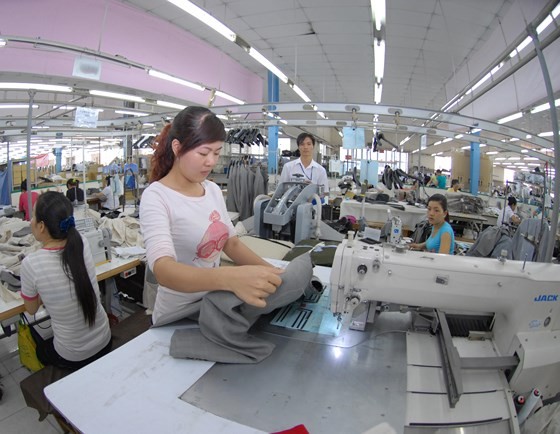
A drop in the number of orders spread from small enterprises to large-scale ones.
Mr. Nguyen Van Nam, director of Thanh Binh Garment Company, said that his company has three production lines of spandex products with more than 100 workers. Lately, his partner – a local company - unexpectedly cut orders, urging him to seek for new sources with low prices or even without profits to get job for his workers.
Other large garment enterprises, including May 10, Viet Tien and Nha Be also experienced the same situation. According to Mr. Truong Van Cam, general secretary of the Vietnam Textile and Apparel Association (Vitas), scarcity of orders is quite popular so export turnover will not be as optimistic as it was expected at the beginning of this year. The number of orders of several garment and textile enterprises merely accounted for 70 percent of that in the same period last year. This makes it impossible for garment and textile industry to achieve export target of this year.
Representative of Vitas said that the main reason of the decline in orders is the ongoing trade war, showing most clearly via a sharp drop in export volume of fiber of Vietnam. Previously, Vietnam produced an average 2.2 million tons of fiber annually, of which 1.5 million tons was for export, accounting for 68 percent of total production. However, since the end of last year, export of fiber has seen uncertainties. This year, fiber consumption has encountered difficulties. In the first six months of this year, fiber export has merely grown 1.1 percent.
Moreover, some countries devaluated their currencies so as to create advantages for export whereas the Vietnamese dong remained stable, causing export products of Vietnam to have higher cost prices, putting export of garment and textile industry at a disadvantage. The industry expected that recently-signed free trade agreements, such as the EU-Vietnam Free Trade Agreement, will strongly promote export.
Nevertheless, up to now, although free trade agreements were signed, they are merely potential markets and have not showed actual effectiveness, leading to the situation that export products are still imposed import tariffs. This might be the reason that importers shifted orders to other countries, causing a shortage of orders for Vietnamese garment and textile firms.
In addition, since the beginning of this year, both firms and experts in garment an textile industry expected that the trade war will help to increase orders for Vietnam. However, in reality, the difficult situation of global economy has caused purchasing power to decline while a shift of orders has not been clear so far.
According to Mr. Pham Xuan Hong, chairman of the Ho Chi Minh City Textile and Garment - Embroidery Association, a shortage of orders has happened but only at some enterprises, especially in the northern region, instead of the whole industry. In Ho Chi Minh City, members of the association still have received orders as normal.
‘Although a decline of orders occurred at some enterprises, overall growth rate of the industry was still higher than the same period last year. Export turnover of the garment and textile industry still might reach $40 billion as although Vietnamese firms are unable to increase export, FDI enterprises are capable of increasing export and making up for the whole industry,’ Mr. Hong said optimistically.
Vitas suggested that firms should put more efforts in order to achieve export target of this year. Especially, in the last half of this year, the industry must gain a growth rate from 11 percent upwards in order for export turnover of this year to reach the $40-billion mark. Of which, firms should try their best to look for orders and maintain production from now to the end of this year. As for large enterprises which are able to sign big contracts, they should share their orders with small enterprises. Domestic enterprises collaborate with customers to establish production chain, meeting rules of origin in accordance with commitments of free trade agreements.
In long term, in order to stabilize orders, domestic enterprises must comply with requirements of brands for sustainable development, hereby they will be recognized by brands for transparency and will attract orders in the future. Besides, enterprises in the industry need to improve their competitiveness as well as apply solutions, such as reducing input costs, standardizing production procedure and management procedure in accordance with their actual situation.
Only by managing production and human in the spirit of the fourth industrial revolution, aiming to turn regular factories into smart factories and not wasting any resource, enterprises are able to survive in the current inconsistent market, said Mr. Cao Huu Hieu, director of the Vietnam National Textile and Garment Group.
The US remained the largest export market of the industry with turnover of $7.22 billion, up 12.84 percent over the same period last year, accounting for 46.9 percent. Exports to countries in the Comprehensive and Progressive Agreement for Trans-Pacific Partnership hit $2.57 billion, up 11.13 percent, accounting for 16.71 percent. Exports to the EU reached $2.05 billion, up 10.46 percent, accounting for 13.36 percent.
























